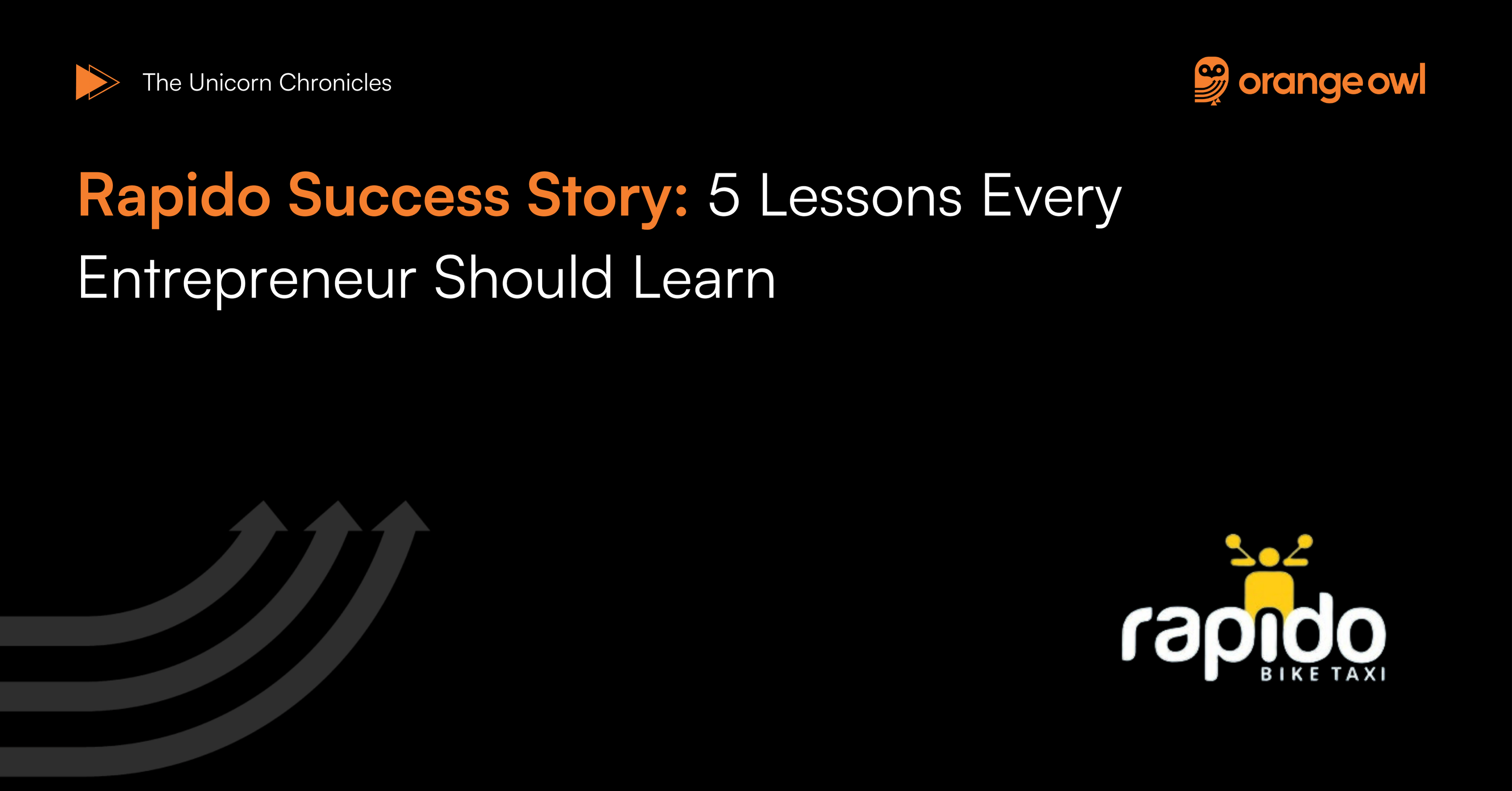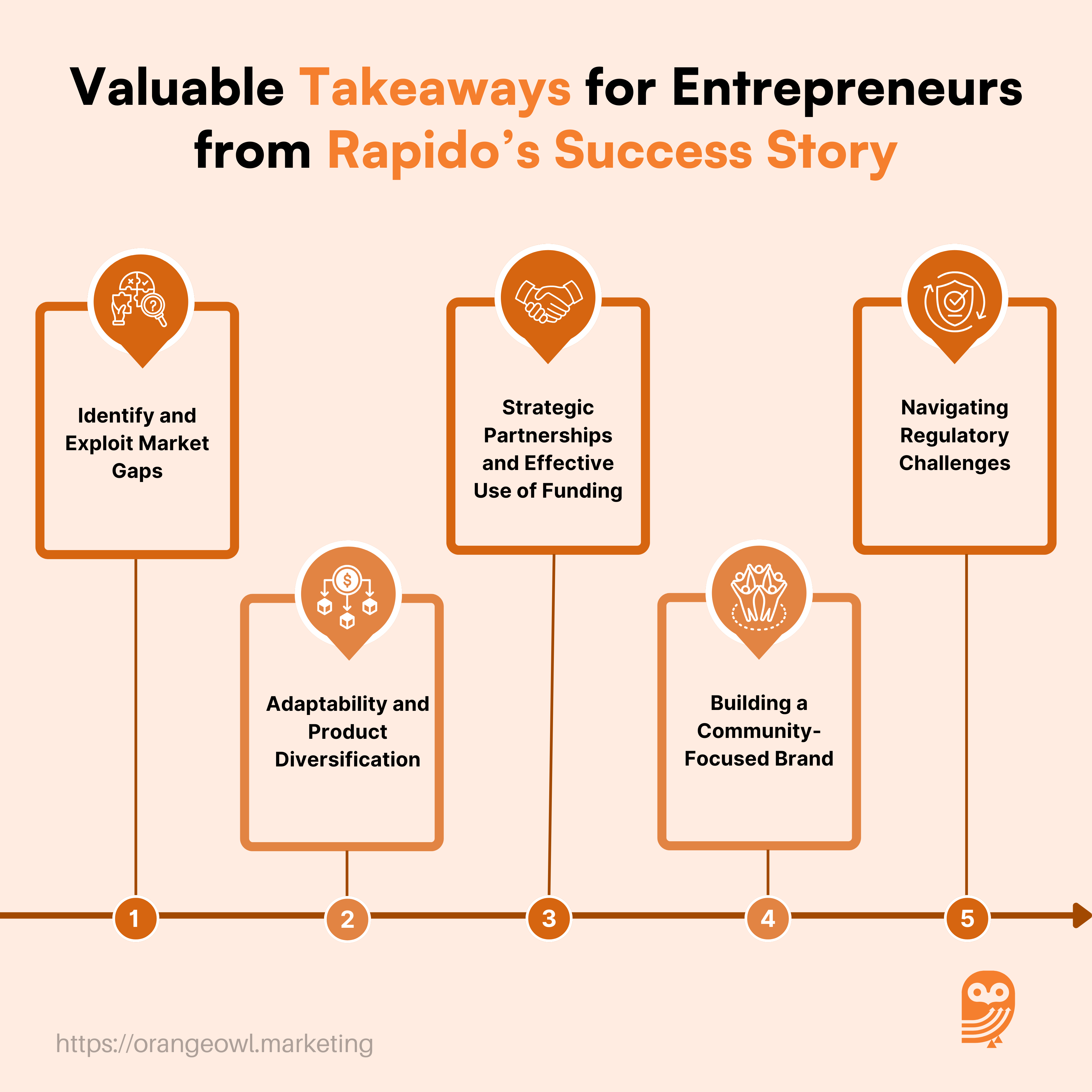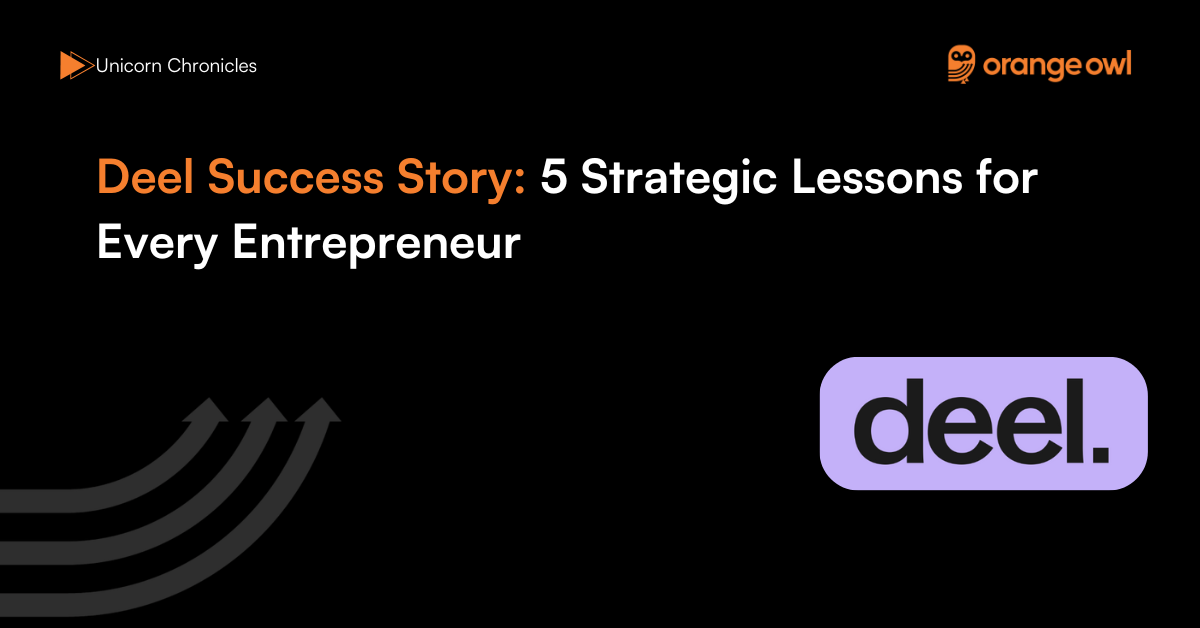Rapido Success Story: 5 Lessons Every Entrepreneur Should Learn
Vivek Goel
February 10, 2025

Table of Contents
Founded in 2015 by Pavan Guntupalli, Rishikesh SR, and Aravind Sanka, Rapido’s success story has quickly emerged as a leader in the urban mobility sector in India. Headquartered in Bangalore, Rapido has become synonymous with affordable bike taxis, catering to the everyday commuting needs of urban dwellers across the nation. With operations in over 100 cities and a network of over 15,000 active daily riders, or “captains,” Rapido has successfully addressed the need for convenient and cost-effective transportation in India’s congested cities.
The idea for Rapido was born out of the founders’ own experiences with traffic congestion and the time-consuming commutes that plague urban India. Initially, the company began as a B2B logistics provider under the brand “the carrier,” focusing on last-mile delivery. However, realizing the limited potential of the logistics sector, they pivoted to a B2C bike taxi service, recognizing an untapped market opportunity to revolutionize urban commuting. The goal was to offer a convenient way for people to beat the traffic using two-wheelers, which are far more efficient in dense urban landscapes than traditional four-wheelers. This shift was a turning point that allowed Rapido to create a scalable and consumer-focused business model.
Reflecting on their entrepreneurial journey, Pavan Guntupalli expressed the foundational belief driving their work: “The journey of building something significant is never easy, but it is always worth it when you solve real problems and make a difference in people’s lives.” This ethos is woven into the very fabric of Rapido’s mission to solve real problems and improve urban commuting.
Strategic Growth and Scaling Tactics behind the Rapido Success Story
Rapido’s growth strategy has been multi-faceted, focusing on technological innovation, strategic partnerships, and market adaptability. The company’s app-based platform is intuitive and user-friendly, allowing commuters to book rides with just a few taps. To make onboarding easy for captains, Rapido implemented a seamless registration process via the Rapido Captain App, verifying riders with a few basic requirements. This simplified process expanded Rapido’s driver network, allowing them to offer affordable rides to a wider audience.
In 2022, Rapido raised $180 million in a Series D funding round led by Swiggy and TVS Motor. This significant infusion of capital was directed towards improving technological infrastructure, expanding the operational team, and enhancing the customer experience.
The partnership with Swiggy also allowed for cross-promotion opportunities, increasing fleet availability and generating additional income sources for captains. These strategic alliances played a crucial role in scaling operations and maintaining Rapido’s competitive edge in the market.
Rapido’s marketing strategy has been a key part of the Rapido success story, driving brand awareness and customer loyalty. They focused on affordability without compromising quality. Rapido offered competitive pricing compared to traditional cab services like Ola and Uber, capitalizing on the cost-efficiency of two-wheelers. Additionally, their innovative campaigns, such as the launch of Bike Pink—featuring female captains for women commuters—demonstrated a commitment to inclusivity and safety, appealing to a broader demographic.
Overcoming Challenges and Standing Out Amidst Competition
Despite the success, Rapido faced significant challenges, ranging from safety concerns to legal battles. Initially, two-wheeler taxis were perceived as unsafe, leading Rapido to implement stringent safety protocols like speed tracking and limiting driver speeds, reassuring customers.
Moreover, regulatory challenges remain an ongoing issue, as many Indian states have yet to officially permit two-wheeler taxis. Rapido has navigated these legal hurdles by actively engaging in advocacy and litigation, aiming to establish a clearer framework for the bike taxi sector.
Competition with established ride-hailing giants like Ola and Uber has pushed Rapido’s success story forward, driving the company to continually differentiate itself. Unlike car-based services that struggle with traffic congestion, Rapido’s two-wheeler model provides faster and more affordable rides for short distances, making it an ideal choice for navigating crowded cities.
As part of its growth, Rapido has also expanded its service offerings, moving into auto-rickshaw rides, cab services, and local deliveries, allowing the company to cater to a diverse set of customer needs.
Aravind Sanka, co-founder of Rapido, shared a powerful perspective on their success: “Success doesn’t come from quick wins, it’s about sticking with your mission and being relentless in pursuing it.” This mindset has been central to Rapido’s ability to persevere and continue scaling its business in the face of competition and challenges.
5 Lessons for Entrepreneurs from the Rapido Success Story
Rapido’s journey offers several valuable takeaways for entrepreneurs

1. Identify and Exploit Market Gaps
Rapido’s founders recognized that India’s congested urban centers needed a faster and cheaper transportation alternative, leading them to create a new category in the ride-hailing sector with bike taxis.
Takeaway: Recognize unmet needs or inefficiencies in the market and create solutions.
Example: A health-tech startup realizes that rural areas lack access to diagnostic labs. They launch a mobile testing van service offering basic health checkups and lab tests, bridging the gap for underserved communities.
2. Adaptability and Product Diversification
Rapido’s ability to pivot from a B2B logistics company to a B2C bike taxi service highlights the importance of being flexible in response to market demands. Their expansion into various services like auto-rickshaws and cabs shows that diversification can strengthen a brand’s market position.
Takeaway: Be willing to pivot your business model or offerings based on market demands.
Example: A B2B SaaS company initially develops a tool for real-time inventory tracking. After user feedback reveals greater demand for an AI-driven demand forecasting feature, they shift focus to predictive analytics, gaining a competitive edge in the logistics sector.
3. Strategic Partnerships and Effective Use of Funding
Collaborations with major players like Swiggy and TVS Motor not only provided Rapido with financial resources but also synergies that enhanced its service delivery. This underscores the importance of forming alliances that align with a company’s growth objectives.
Takeaway: Collaborate with organizations that align with your business goals for mutual growth.
Example: A sustainable fashion brand partners with local artisans and an e-commerce platform. The artisans bring unique handmade designs, while the platform ensures wider visibility and sales, creating a win-win situation.
4. Building a Community-Focused Brand
Rapido’s efforts to build trust through safety measures, inclusive services like Bike Pink, and a customer-first approach have been key differentiators. Creating a community-centric brand can lead to deeper customer engagement and loyalty.
Takeaway: Establish a brand that resonates with shared values to foster emotional connections.
Example: An electric vehicle (EV) startup launches local “Go Green” campaigns, providing free workshops on EV maintenance and encouraging eco-friendly practices, which creates a strong emotional bond with its user base.
5. Navigating Regulatory Challenges
Rapido’s persistence in addressing legal obstacles shows the importance of resilience in entrepreneurship. They have shown that a proactive approach to regulatory hurdles, combined with strategic advocacy, can pave the way for long-term success.
Takeaway: Approach regulatory or market challenges with persistence and strategic solutions.
Example: A ride-hailing company faces bans in some cities due to local taxi unions. Instead of retreating, they lobby for regulatory reforms, demonstrate safety features, and create partnerships with unions for job creation.
Conclusion
Rapido success story is one of innovation, adaptability, and strategic growth, demonstrating how a clear understanding of market needs, paired with a bold business model, can lead to success even in a highly competitive sector. As urban India continues to expand, Rapido’s trajectory sets a compelling example of how startups can thrive by embracing technology, focusing on customer experience, and maintaining the flexibility to evolve with the times.


